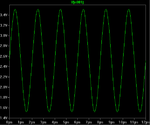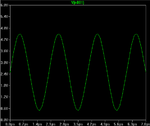himadri117
Newbie level 5
I have a RF Frontend that has an 4 IF signal output (2 I channel and 2 Q channel from 2 receiving anettans). Each channel of the IF has a signal rangining from 1.5V to 3.5V with a DC offset of 2.5V.
IF output signal:

I want to sample the signal with an ADC that has a reference voltage from 0 to 5V and use the mid range of 2.5V for better sampling.
So,I prefer to shift the signal and amplify to make it from 0.5V to 4.5V with a offset of 2.5V.
Desired output signal

I tried coupled capacitor then level shift and gain with op-amp, also other shifting circuit, but the coupled capacitor to block the DC causes a little phase shift which is not desireable. So I don't want to filter the DC and aamplify to my desired signal. Please suggest me a circuit that will work without delay and phase shift.
IF output signal:

I want to sample the signal with an ADC that has a reference voltage from 0 to 5V and use the mid range of 2.5V for better sampling.
So,I prefer to shift the signal and amplify to make it from 0.5V to 4.5V with a offset of 2.5V.
Desired output signal

I tried coupled capacitor then level shift and gain with op-amp, also other shifting circuit, but the coupled capacitor to block the DC causes a little phase shift which is not desireable. So I don't want to filter the DC and aamplify to my desired signal. Please suggest me a circuit that will work without delay and phase shift.
Last edited by a moderator:
